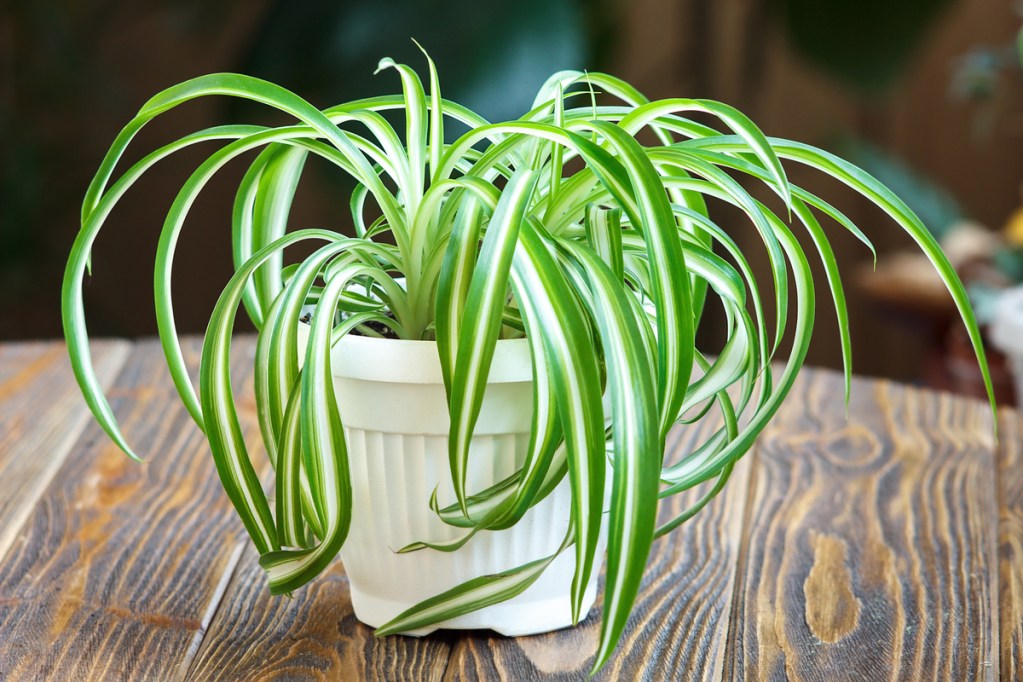Spider plants are a common choice for beginners, due to how quickly they grow and how easy they are to take care of. While it’s not a prized Monstera albo, it deserves a spot in any indoor plant collection, as it makes for a striking hanging basket plant with its cascading offshoots, or spiderettes. Whether you’re a beginner or an expert, there’s a lot to love about these charming houseplants. To help you get started, here’s our guide to spider plant varieties and how to care for them.
What is a spider plant?

Originating from South Africa, the spider plant, or Chlorophytum comosum, is an incredibly productive houseplant. It’s defined by arching leaves that resemble spider legs and the spiderettes that emerge from those leaves — plus the spiderettes that emerge from those spiderettes, and so on. The leaves can be straight or curly, and they come in variations of solid greens and striped patterns. Occasionally, spider plants push out dainty white blooms; these flowers are relatively insignificant but are an attractive sight.
Because of its productive growth, the spider plant makes for a beautiful hanging basket plant as its spiderettes cascade. And if you find that your plant is quickly taking over your space, consider propagating the spiderettes and sharing them with fellow plant lovers! You can snip them off and let them root in water or soil. Alternatively, you can keep the spiderettes on the mother plant and place their aerial roots in soil and then snip them off when they form longer roots. The spider plant thrives as a perennial in climate zones 9 through 11, but it can survive as a houseplant anywhere.
How do you care for a spider plant?

Spider plant care is easy. As with most houseplants, it’ll thrive with bright indirect light and well-draining soil. If you keep it outside, it does prefer shade during the summer months. It also appreciates cooler temperatures, thriving between 55 and 65 degrees Fahrenheit. While the spider plant dislikes wet feet, it does appreciate evenly moist soil.
If you notice browning leaf tips, the culprit could be many things. If you’ve pulled your plant back from overexposure to light and increased the humidity, consider the watering aspect. You might be under-watering your plant or using hard water, so give your plant a good soak with filtered water. Overfertilizing can also be an issue, so consider cutting back on it as well if you notice any crispy tips.
How many spider plant varieties are there?

In the Chlorophytum genus, there are roughly 200 different species. That’s a lot of spider plants! However, not all of those are commonly grown as houseplants. Chlorophytum comosum (also called common spider plant) is the species that is most commonly grown as a houseplant, and it is broken down into three common varieties.
A few other Chlorophytum species are also grown as houseplants, although they aren’t quite as common as comosum. Some of these have other common names, so you may find them in nurseries under names like false lily turf, zebra grass, and bichetii grass.
Types of spider plants

If you’re searching for the perfect plant to round out your houseplant collection, get started with these lush spider plant varieties.
Bonnie spider plant (Chlorophytum comosum “Bonnie”)
This variety of spider plants features leaves that curl. It can either be a variegated variety with a white stripe down the middle between two green edges or a plant that’s purely green. The striped variety tends to be more common, but the solid color can be found at nurseries and online, too. This type of spider plant can tolerate lower light and periods of drought, which makes it quite easy to care for.
Zebra grass spider plant (Chlorophytum laxum “zebra”)
The zebra grass spider plant has arching green leaves edged with a cream or white color. This variety tends to grow wide as opposed to tall. Compared to other spider plants, this type is harder to track down. If you can find it, it makes for a beautiful border plant, doing best in light shade outside.
Hawaiian spider plant (Chlorophytum viridescens “Hawaiian”)
The Hawaiian spider plant starts out with variegated leaves with gold center stripes, but the variegation fades with time to leave you with faintly striped green leaves. Because its leaves are relatively large, this variety can be mistaken for a dracaena. As with most spider plants, it thrives in bright indirect light and prefers moist soil throughout the growing season.
Variegated spider plant (Chlorophytum comosum “vittatum”)
The vittatum spider plant flaunts arching white or yellow leaves with thin green margins. Its leaves can grow up to one to two feet tall in length and width, so this spider plant is great for landscaping uses. Plus, it’s drought-tolerant and generally pest-free, so it’s easy to maintain. Chances are that if you’re looking for a spider plant, this is probably one of the most common types out there.
Reverse spider plant (Chlorophytum comosum “variegatum”)
More or less the opposite of the vittatum spider plant, the variegatum features arching green leaves with white margins — appropriately, it’s sometimes called a “reverse spider plant.” When it comes to spider plants that you can simply grab from a supermarket or nursery, the variegatum is another go-to. It’s similar to the zebra spider plant, except its edges aren’t as bright.
With dappled light, ample watering, and a bit of humidity, you’ll be on your way to witnessing cascades of spiderettes. And while the spider plant is best known for its striking form, don’t forget to pay attention to leaf variegation and texture when you’re shopping for one. With everything from the curly green Bonnie spider plant to the arching reverse spider plant with bold green stripes, you can build a diverse collection of these prolific beauties.




